Konark, Puri and Bhubaneswar form a virtual triangle popularly known as "Swarna Tribhuj" or the golden triangle. About twenty kilometres from Bhubaneswar lies Pipili, famous for patching cloth design locally known as Chandua - from where the road towards Konark bifurcates and the straight road proceeds to Puri. Konark is 44 kms from Pipili. A marine drive above 30 kms along the sea leads from Puri to Konark completing the triangle.
KONARK
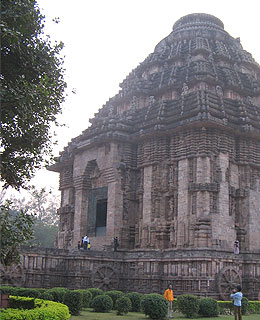 The Temple of the Sun God of Konark is an architectural marvel. According to mythology, Shamba, son of Lord Krishna was smitten with leprosy owing to the curse of the latter. The Temple of the Sun God of Konark is an architectural marvel. According to mythology, Shamba, son of Lord Krishna was smitten with leprosy owing to the curse of the latter. 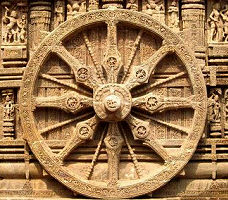 Shamba underwent severe penance for twelve years near the confluence of Chandrabhaga river with the sea at Konark and ultimately succeeded in pleasing the Sun God, the healer of all skin diseases and was cured of his illness. In gratitude, he decided to erect a temple in the honour of the Sun God Surya. The day following his cure, while Shamba was bathing in the Chandrabhaga he discovered an image of the God, which had been fashioned out of Surya's body by Viswakarma. Samba installed this image in a temple built by him. Since then throughout the ages this place has been regarded as a pilgrimage. The present temple was built by king Langula Narsingha Deva of the Ganga Dynasty in the 13th century A.D. Dedicated to Surya the Sun God, it is also called the Black Pagoda. Shaped like a Ratha or chariot drawn-by seven horses in motion it represents Time - the Sun God driving across the sky. According to local legend, the temple had a great aura of power that came from very powerful magnets said to have been built into the tower that allowed the deity's throne to hover in mid-air. Konarak was sacked by the Muslim army headed by 'Kalapahad' in the 15th century A.D. Thereafter, over the centuries, sand engulfed the damaged structure and salty breezes eroded the stone. It remained buried under a huge mound of sand until the early 20th century, when it was found by British archaeologists under the initiative of Lord Curzon in 1904 and restoration began under the British. Although the tower over the Garvagriha (Sanctum Sanctorum) was beleived to be destroyed but the Jagamohana (Audience Hall) was found intact. Portions of the Nata Mandir (Dancing Hall) and Bhoga Mandir (Dinning Hall) have survived. Shamba underwent severe penance for twelve years near the confluence of Chandrabhaga river with the sea at Konark and ultimately succeeded in pleasing the Sun God, the healer of all skin diseases and was cured of his illness. In gratitude, he decided to erect a temple in the honour of the Sun God Surya. The day following his cure, while Shamba was bathing in the Chandrabhaga he discovered an image of the God, which had been fashioned out of Surya's body by Viswakarma. Samba installed this image in a temple built by him. Since then throughout the ages this place has been regarded as a pilgrimage. The present temple was built by king Langula Narsingha Deva of the Ganga Dynasty in the 13th century A.D. Dedicated to Surya the Sun God, it is also called the Black Pagoda. Shaped like a Ratha or chariot drawn-by seven horses in motion it represents Time - the Sun God driving across the sky. According to local legend, the temple had a great aura of power that came from very powerful magnets said to have been built into the tower that allowed the deity's throne to hover in mid-air. Konarak was sacked by the Muslim army headed by 'Kalapahad' in the 15th century A.D. Thereafter, over the centuries, sand engulfed the damaged structure and salty breezes eroded the stone. It remained buried under a huge mound of sand until the early 20th century, when it was found by British archaeologists under the initiative of Lord Curzon in 1904 and restoration began under the British. Although the tower over the Garvagriha (Sanctum Sanctorum) was beleived to be destroyed but the Jagamohana (Audience Hall) was found intact. Portions of the Nata Mandir (Dancing Hall) and Bhoga Mandir (Dinning Hall) have survived.
BHUBANESWAR
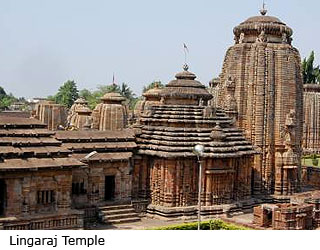 Bhubaneswar, The modern capital of Orissa, is known as the "Temple City" because of around five hundred temples still standing. Many more have been destroyed. It is said that Bhubaneswar had thousands of such temples. These marvellous pieces of architecture tell the story of the history of Orissan style of temple building - the Kalinga style, spreading over 7th century to 16th Century A. D. History of the temple city is quite obscure before this period. It is interesting to note that evidence of its contact with the Roman Empire has been found while excavating the remains of Sisupalgarh (beleived to be the ancient capital of Kalinga), only a short distance from Bhubaneswar. The most famous of the temples is the Lingaraj Temple. This temple is dedicated to Shiva and the majestic linga of colossus appearance is known as Lord Lingaraj. To the north of the Lingaraja temple lies a lake called Bindusarobar. Of the best preserved of the oldest temples is the Parasuramesvara temple - probably built during the first quarter of the 7th century A.D. Nearby, is the temple of Mukteswar, otherwise refered to as "poetry in stone" because of its strikingly beautiful carvings and sculptures. The Siddheswar temple, built at a later period is in the same compound. Bhubaneswar, The modern capital of Orissa, is known as the "Temple City" because of around five hundred temples still standing. Many more have been destroyed. It is said that Bhubaneswar had thousands of such temples. These marvellous pieces of architecture tell the story of the history of Orissan style of temple building - the Kalinga style, spreading over 7th century to 16th Century A. D. History of the temple city is quite obscure before this period. It is interesting to note that evidence of its contact with the Roman Empire has been found while excavating the remains of Sisupalgarh (beleived to be the ancient capital of Kalinga), only a short distance from Bhubaneswar. The most famous of the temples is the Lingaraj Temple. This temple is dedicated to Shiva and the majestic linga of colossus appearance is known as Lord Lingaraj. To the north of the Lingaraja temple lies a lake called Bindusarobar. Of the best preserved of the oldest temples is the Parasuramesvara temple - probably built during the first quarter of the 7th century A.D. Nearby, is the temple of Mukteswar, otherwise refered to as "poetry in stone" because of its strikingly beautiful carvings and sculptures. The Siddheswar temple, built at a later period is in the same compound. 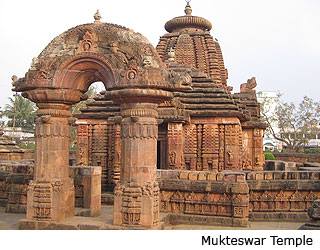 The nearby temple complex of Kedar-Gouri houses the famous "Kunda" or well whose water is said to have healing properties. Rajarani temple is aesthetically unique, sculpted with graceful feminine figures. However, this temple is no longer used for worship as there is no deity installed. The 8th-century Vaital temple has a reputation of being a powerful tantrik centre. Inside the temple stands the mighty Chamunda (Kali), wearing a necklace of skulls with a corpse at her feet. Tantriks find the dimly lit interior of the temple an ideal place for absorbing age-old currents of power that emanate from this spot. The nearby temple complex of Kedar-Gouri houses the famous "Kunda" or well whose water is said to have healing properties. Rajarani temple is aesthetically unique, sculpted with graceful feminine figures. However, this temple is no longer used for worship as there is no deity installed. The 8th-century Vaital temple has a reputation of being a powerful tantrik centre. Inside the temple stands the mighty Chamunda (Kali), wearing a necklace of skulls with a corpse at her feet. Tantriks find the dimly lit interior of the temple an ideal place for absorbing age-old currents of power that emanate from this spot. 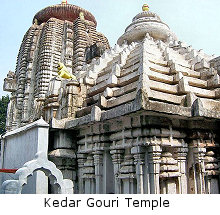 To the west of Bhubaneswar are the twin hills of Khandagiri and Udaygiri. The Udayagiri Caves were occupied by the Buddhist monks as early as the 2nd century BC. Dhauligiri (or better known as Dhauli) has Ashokan edicts carved on rocks at its foothills. These date back to 2nd century BC. There is a beautiful Buddhist temple built with Japanese collaboration. The open air Nandan Kanan Zoo is famous for viewing the Royal Bengal tiger and white tigers along with some rare species from the animal kingdom. Pipili (at the tri-junction of Puri and Konark roads) is a village famous for its applique work, originally only made for the temple Gods. The State Museum has a collection of sculptures, coins, exhibits from the pre-historic age, rare manuscripts, traditional and folk musical instruments which are worth seeing and provides to the visitor, a glimpse into ancient history of Orissa. Bhubansehwar is famous for the handicraft items too. The hand woven cotton saris (popularly known as katki) are quite popular. There are stone decorative pieces and items of brass built by local sculptors and artisans, delicately and exquisitly made. To the west of Bhubaneswar are the twin hills of Khandagiri and Udaygiri. The Udayagiri Caves were occupied by the Buddhist monks as early as the 2nd century BC. Dhauligiri (or better known as Dhauli) has Ashokan edicts carved on rocks at its foothills. These date back to 2nd century BC. There is a beautiful Buddhist temple built with Japanese collaboration. The open air Nandan Kanan Zoo is famous for viewing the Royal Bengal tiger and white tigers along with some rare species from the animal kingdom. Pipili (at the tri-junction of Puri and Konark roads) is a village famous for its applique work, originally only made for the temple Gods. The State Museum has a collection of sculptures, coins, exhibits from the pre-historic age, rare manuscripts, traditional and folk musical instruments which are worth seeing and provides to the visitor, a glimpse into ancient history of Orissa. Bhubansehwar is famous for the handicraft items too. The hand woven cotton saris (popularly known as katki) are quite popular. There are stone decorative pieces and items of brass built by local sculptors and artisans, delicately and exquisitly made.
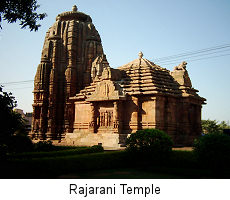 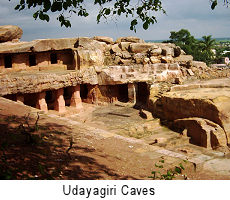 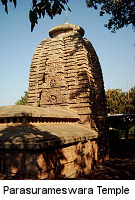 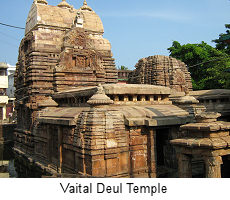
|
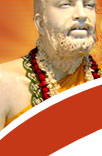

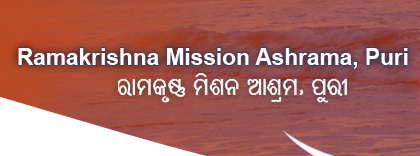


 The Temple of the Sun God of Konark is an architectural marvel. According to mythology, Shamba, son of Lord Krishna was smitten with leprosy owing to the curse of the latter.
The Temple of the Sun God of Konark is an architectural marvel. According to mythology, Shamba, son of Lord Krishna was smitten with leprosy owing to the curse of the latter.  Shamba underwent severe penance for twelve years near the confluence of Chandrabhaga river with the sea at Konark and ultimately succeeded in pleasing the Sun God, the healer of all skin diseases and was cured of his illness. In gratitude, he decided to erect a temple in the honour of the Sun God Surya. The day following his cure, while Shamba was bathing in the Chandrabhaga he discovered an image of the God, which had been fashioned out of Surya's body by Viswakarma. Samba installed this image in a temple built by him. Since then throughout the ages this place has been regarded as a pilgrimage. The present temple was built by king Langula Narsingha Deva of the Ganga Dynasty in the 13th century A.D. Dedicated to Surya the Sun God, it is also called the Black Pagoda. Shaped like a Ratha or chariot drawn-by seven horses in motion it represents Time - the Sun God driving across the sky. According to local legend, the temple had a great aura of power that came from very powerful magnets said to have been built into the tower that allowed the deity's throne to hover in mid-air. Konarak was sacked by the Muslim army headed by 'Kalapahad' in the 15th century A.D. Thereafter, over the centuries, sand engulfed the damaged structure and salty breezes eroded the stone. It remained buried under a huge mound of sand until the early 20th century, when it was found by British archaeologists under the initiative of Lord Curzon in 1904 and restoration began under the British. Although the tower over the Garvagriha (Sanctum Sanctorum) was beleived to be destroyed but the Jagamohana (Audience Hall) was found intact. Portions of the Nata Mandir (Dancing Hall) and Bhoga Mandir (Dinning Hall) have survived.
Shamba underwent severe penance for twelve years near the confluence of Chandrabhaga river with the sea at Konark and ultimately succeeded in pleasing the Sun God, the healer of all skin diseases and was cured of his illness. In gratitude, he decided to erect a temple in the honour of the Sun God Surya. The day following his cure, while Shamba was bathing in the Chandrabhaga he discovered an image of the God, which had been fashioned out of Surya's body by Viswakarma. Samba installed this image in a temple built by him. Since then throughout the ages this place has been regarded as a pilgrimage. The present temple was built by king Langula Narsingha Deva of the Ganga Dynasty in the 13th century A.D. Dedicated to Surya the Sun God, it is also called the Black Pagoda. Shaped like a Ratha or chariot drawn-by seven horses in motion it represents Time - the Sun God driving across the sky. According to local legend, the temple had a great aura of power that came from very powerful magnets said to have been built into the tower that allowed the deity's throne to hover in mid-air. Konarak was sacked by the Muslim army headed by 'Kalapahad' in the 15th century A.D. Thereafter, over the centuries, sand engulfed the damaged structure and salty breezes eroded the stone. It remained buried under a huge mound of sand until the early 20th century, when it was found by British archaeologists under the initiative of Lord Curzon in 1904 and restoration began under the British. Although the tower over the Garvagriha (Sanctum Sanctorum) was beleived to be destroyed but the Jagamohana (Audience Hall) was found intact. Portions of the Nata Mandir (Dancing Hall) and Bhoga Mandir (Dinning Hall) have survived. Bhubaneswar, The modern capital of Orissa, is known as the "Temple City" because of around five hundred temples still standing. Many more have been destroyed. It is said that Bhubaneswar had thousands of such temples. These marvellous pieces of architecture tell the story of the history of Orissan style of temple building - the Kalinga style, spreading over 7th century to 16th Century A. D. History of the temple city is quite obscure before this period. It is interesting to note that evidence of its contact with the Roman Empire has been found while excavating the remains of Sisupalgarh (beleived to be the ancient capital of Kalinga), only a short distance from Bhubaneswar. The most famous of the temples is the Lingaraj Temple. This temple is dedicated to Shiva and the majestic linga of colossus appearance is known as Lord Lingaraj. To the north of the Lingaraja temple lies a lake called Bindusarobar. Of the best preserved of the oldest temples is the Parasuramesvara temple - probably built during the first quarter of the 7th century A.D. Nearby, is the temple of Mukteswar, otherwise refered to as "poetry in stone" because of its strikingly beautiful carvings and sculptures. The Siddheswar temple, built at a later period is in the same compound.
Bhubaneswar, The modern capital of Orissa, is known as the "Temple City" because of around five hundred temples still standing. Many more have been destroyed. It is said that Bhubaneswar had thousands of such temples. These marvellous pieces of architecture tell the story of the history of Orissan style of temple building - the Kalinga style, spreading over 7th century to 16th Century A. D. History of the temple city is quite obscure before this period. It is interesting to note that evidence of its contact with the Roman Empire has been found while excavating the remains of Sisupalgarh (beleived to be the ancient capital of Kalinga), only a short distance from Bhubaneswar. The most famous of the temples is the Lingaraj Temple. This temple is dedicated to Shiva and the majestic linga of colossus appearance is known as Lord Lingaraj. To the north of the Lingaraja temple lies a lake called Bindusarobar. Of the best preserved of the oldest temples is the Parasuramesvara temple - probably built during the first quarter of the 7th century A.D. Nearby, is the temple of Mukteswar, otherwise refered to as "poetry in stone" because of its strikingly beautiful carvings and sculptures. The Siddheswar temple, built at a later period is in the same compound.  The nearby temple complex of Kedar-Gouri houses the famous "Kunda" or well whose water is said to have healing properties. Rajarani temple is aesthetically unique, sculpted with graceful feminine figures. However, this temple is no longer used for worship as there is no deity installed. The 8th-century Vaital temple has a reputation of being a powerful tantrik centre. Inside the temple stands the mighty Chamunda (Kali), wearing a necklace of skulls with a corpse at her feet. Tantriks find the dimly lit interior of the temple an ideal place for absorbing age-old currents of power that emanate from this spot.
The nearby temple complex of Kedar-Gouri houses the famous "Kunda" or well whose water is said to have healing properties. Rajarani temple is aesthetically unique, sculpted with graceful feminine figures. However, this temple is no longer used for worship as there is no deity installed. The 8th-century Vaital temple has a reputation of being a powerful tantrik centre. Inside the temple stands the mighty Chamunda (Kali), wearing a necklace of skulls with a corpse at her feet. Tantriks find the dimly lit interior of the temple an ideal place for absorbing age-old currents of power that emanate from this spot.  To the west of Bhubaneswar are the twin hills of Khandagiri and Udaygiri. The Udayagiri Caves were occupied by the Buddhist monks as early as the 2nd century BC. Dhauligiri (or better known as Dhauli) has Ashokan edicts carved on rocks at its foothills. These date back to 2nd century BC. There is a beautiful Buddhist temple built with Japanese collaboration. The open air Nandan Kanan Zoo is famous for viewing the Royal Bengal tiger and white tigers along with some rare species from the animal kingdom. Pipili (at the tri-junction of Puri and Konark roads) is a village famous for its applique work, originally only made for the temple Gods. The State Museum has a collection of sculptures, coins, exhibits from the pre-historic age, rare manuscripts, traditional and folk musical instruments which are worth seeing and provides to the visitor, a glimpse into ancient history of Orissa. Bhubansehwar is famous for the handicraft items too. The hand woven cotton saris (popularly known as katki) are quite popular. There are stone decorative pieces and items of brass built by local sculptors and artisans, delicately and exquisitly made.
To the west of Bhubaneswar are the twin hills of Khandagiri and Udaygiri. The Udayagiri Caves were occupied by the Buddhist monks as early as the 2nd century BC. Dhauligiri (or better known as Dhauli) has Ashokan edicts carved on rocks at its foothills. These date back to 2nd century BC. There is a beautiful Buddhist temple built with Japanese collaboration. The open air Nandan Kanan Zoo is famous for viewing the Royal Bengal tiger and white tigers along with some rare species from the animal kingdom. Pipili (at the tri-junction of Puri and Konark roads) is a village famous for its applique work, originally only made for the temple Gods. The State Museum has a collection of sculptures, coins, exhibits from the pre-historic age, rare manuscripts, traditional and folk musical instruments which are worth seeing and provides to the visitor, a glimpse into ancient history of Orissa. Bhubansehwar is famous for the handicraft items too. The hand woven cotton saris (popularly known as katki) are quite popular. There are stone decorative pieces and items of brass built by local sculptors and artisans, delicately and exquisitly made.


